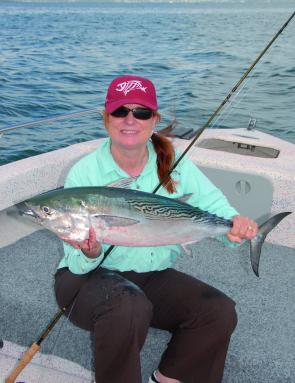There is a definite degree of madness involved in chasing mac tuna.
I’ve spent many hours, and fuel, chasing mac tuna all over the bay only to see them fire up in the distance and then immediately shut down when I get within casting distance. And then at other times they can be real darlings, choosing to surface right by the boat for a splash and slash at whatever baitfish has been rounded up and then almost fighting over a fly when it lands among them. But I suppose that’s all part of the fun!
One thing that mac tuna do have going for them is sheer availability at this time of year. In Moreton Bay waters they were about in October, commonly seen in November and should hold over right through summer and into autumn. While they can be challenging they will nearly always offer an opportunity if mackerel or northern blue tuna are scarce on the day.
Birds are the key to tracking pelagic action in Brisbane waters and it's always an exciting time to see a big flock hovering over water being ripped to foam by surface feeders. From a distance, as the birds and activity are coming ever closer, mac tuna usually present as silver flashes half leaping out or simply slashing in a confined area in a very determined and spectacular manner. They are showy fish with chrome-like sides that reflect the sunlight.
The action usually unfolds in two ways. Firstly, the boat is allowed to approach and the fly gets into the area of action or, secondly, the fish decide to move, the birds suddenly lift, and the school then shows as a large area of vee ripples moving briskly forward (or suddenly backwards, or even under the boat, mac tuna are like that!)
If the school stays put and you are able to get your fly into the action, the trick is to retrieve it back as quickly as possible. The 'take' will usually be a hard draw or jolt with a bit of spray visible as the fish actually dives on the retreating fly. Then the hooked mac tuna will make a very determined and seemingly unstoppable run for at least 100m, maybe more if he's a big bloke over 5kg – exciting stuff!
During those first couple of make-or-break seconds the fly line and backing must be allowed to exit the rod cleanly and unobstructed. It’s amazing what becomes expendable when you’ve hooked up, you could loose the shirt off your back if it gets in the way.
At the end of that first run the fish will still pull determinedly and quite spiritedly right to the boat. I have seen a couple of mac tuna actually pull that hard and for so long that they die during the fight. They really give it their all.
In the other situation, when the fish move off in a vee ripple just below the surface, bring the boat as close as possible to the moving school. When close enough, fly cast to the front of the school and, because they are so aggressive, this should hook a leader fish.
If the school does suddenly stop moving and commences to feed, then do not turn off the engine as they may spook. Any sudden change upsets them. My advice is that if they accept the boat close by then leave the engine running while casting.
Mac tuna are a sportfish due to their power and pace and fly anglers are going to require strong tackle for success. A good mac tuna rod is a quality 8wt or 9wt outfit, or even a 10wt if the fish are good sized and spotty mackerel or long tailed tuna are also about the area.
A successful rod requires both power to play a fish and casting ability. I’m a fan of G.Loomis gear and I've tried out the Cross Current GLX 8wt (FR1088-4 CC GLX) and the X-Perience 8wt (FR 1088-4) on these fish with interesting results.
The GLX is a bit lighter and has the lead on finish and overall presentation, and the no-frills X-Perience is very hard to overlook for an angler on a tight budget.
Due to mac tuna’s prolonged fast runs the reel will need to have a strong, smooth drag plus plenty of capacity for a fly line and lots of backing. A 50lb braid seems to be the backing of choice these days and if at least 200m will fit on the reel, along with the fly line, the reel should do the job fine.
The fly line can be any sort so long as it is clear, or has a clear tip, has an intermediate sink rate and is a weight forward model. If dollars are scarce it's hard to go past the budget Snowbee range that work well in the summer salt water conditions. I've used them and have been happy with their performance.
The ideal fly should be a small baitfish style on strong hooks. I've relied on the Gamakatsu SL 12S hooks for years for everything from barra to tuna, but do remember that a range of sizes is important. Surf Candy or Glass Minnow style flies on hooks from 1/0 back to size 1 or 2 should be in your arsenal as some days the fish are concentrating on quite small flies and won't budge from them.
A store-bought rod length leader with a breaking strain of 6kg or 8kg is fine. When I've nibbled a fair bit from the end of the store-bought job I replenish the tip with some 16lb FC 100. It's strong and the fish seem to like it.
Reads: 3194
Always remember to match-the-hatch – This mac tuna had been eating small baitfish.

The author's wife Denise with a very good sized Moreton Bay mac tuna.




